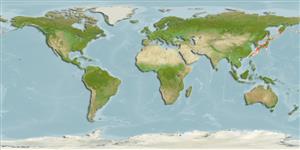Teleostei (teleosts) >
Perciformes/Zoarcoidei (Eelpouts and pricklebacks) >
Stichaeidae (Pricklebacks) > Stichaeinae
Etymology: Stichaeus: Greek, stix, -ichos = row (Ref. 45335).
Eponymy: Alexander Vasilevich Grigoriev (1848–1908) was a Russian botanist and ethnographer who became Secretary of the Imperial Russian Geographical Society (1883–1903). [...] (Ref. 128868), visit book page.
More on author: Herzenstein.
Environment: milieu / climate zone / depth range / distribution range
Ecology
Marine; bathydemersal; depth range 258 - 300 m (Ref. 51666). Temperate
Northwest Pacific: southern Okhotsk Sea and southern Kuril Islands, northern Japan Sea coasts from De Kastri Bay to Korean Peninsula, to Yellow Sea, Pacific coast of Japan to Tokyo.
Size / Weight / Age
Maturity: Lm ? range ? - ? cm
Max length : 60.0 cm TL male/unsexed; (Ref. 56557)
Found in sandy to muddy bottoms up to 300 meters (Ref. 51666).
Life cycle and mating behavior
Maturity | Reproduction | Spawning | Eggs | Fecundity | Larvae
Masuda, H., K. Amaoka, C. Araga, T. Uyeno and T. Yoshino, 1984. The fishes of the Japanese Archipelago. Vol. 1. Tokai University Press, Tokyo, Japan. 437 p. (text). (Ref. 559)
IUCN Red List Status (Ref. 130435: Version 2024-1)
Threat to humans
Harmless
Human uses
Tools
Special reports
Download XML
Internet sources
Estimates based on models
Preferred temperature (Ref.
123201): 1.3 - 12.6, mean 1.8 °C (based on 10 cells).
Phylogenetic diversity index (Ref.
82804): PD
50 = 0.5312 [Uniqueness, from 0.5 = low to 2.0 = high].
Bayesian length-weight: a=0.00316 (0.00162 - 0.00617), b=3.15 (2.97 - 3.33), in cm total length, based on LWR estimates for this species & (Sub)family-body (Ref.
93245).
Trophic level (Ref.
69278): 4.4 ±0.3 se; based on diet studies.
Resilience (Ref.
120179): Low, minimum population doubling time 4.5 - 14 years (Preliminary K or Fecundity.).
Fishing Vulnerability (Ref.
59153): Moderate vulnerability (44 of 100).
